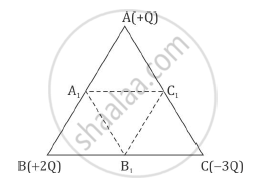Advertisements
Advertisements
Question
A point charge q0 is moving along a circular path of radius a, with a point charge Q at the centre of the circle. The kinetic energy of q0 is ______.
Options
`(q_0Q)/(4piε_0a)`
`(q_0Q)/(8piε_0a)`
`(q_0Q)/(4piε_0a^2)`
`(q_0Q)/(8piε_0a^2)`
Solution
A point charge q0 is moving along a circular path of radius a, with a point charge Q at the centre of the circle. The kinetic energy of q0 is `underlinebb((q_0Q)/(8piε_0a))`.
Explanation:
q0 is moving around a circular path of radius a with a point charge Q at the centre of the circle. To calculate the kinetic energy of q0, we can put,
Electrostatic force due to charges = Centripetal force
`(kQq_0)/r^2 = (mv^2)/r`
The radius of the circle given in the question is a
`(kQq_0)/a^2 = (mv^2)/a`
`(kQq_0)/a = mv^2` ............(i)
Kinetic energy is equal to `1/2m"v"^2`.
Multiplying (i) by `1/2`,
`1/2(kQq_0)/a = 1/2mv^2`
`1/2 xx 1/((4piepsilon_0)) xx Q xx q_0/a = 1/2mv^2`
`(Qq_0)/(8piepsilon_0a) = 1/2mv^2`
APPEARS IN
RELATED QUESTIONS
Three point charges, + Q + 2Q and – 3Q are placed at the vertices of an equilateral triangle ABC of side l. If these charges are displaced to the mid-point A1, B1 and C1, respectively, find the amount of the work done in shifting the charges to the new locations.

In a hydrogen atom, the electron and proton are bound at a distance of about 0.53 Å:
(a) Estimate the potential energy of the system in eV, taking the zero of the potential energy at infinite separation of the electron from proton.
(b) What is the minimum work required to free the electron, given that its kinetic energy in the orbit is half the magnitude of potential energy obtained in (a)?
(c) What are the answers to (a) and (b) above if the zero of potential energy is taken at 1.06 Å separation?
Guess a possible reason why water has a much greater dielectric constant (= 80) than say, mica (= 6).
Why must electrostatic field be normal to the surface at every point of a charged conductor?
The electrostatic potential energy of two-point charges, 1 µC each, placed 1 meter apart in the air is:
If stretch in a spring of force constant k is tripled then the ratio of elastic potential energy in the two cases will be:
Potential energy of two equal negative point charges 2µc each held lm apart in air is:-
In bringing one electron towards another electrons, the electrostatic potential energy of the system will.
